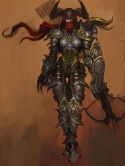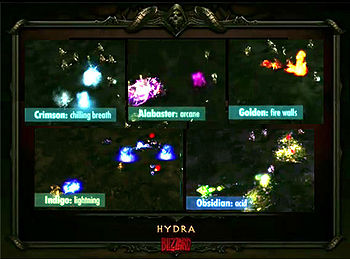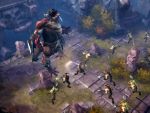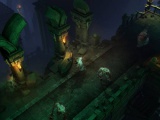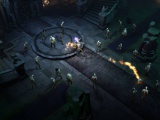Difference between revisions of "Diablo 3 Basics"
m (→Armor and Weapon Types) |
GraviticWar (talk | contribs) m (Grammatical corrections) |
||
| Line 238: | Line 238: | ||
Players will see small-scale demonic events, as in previous games, but the developers have promised that the scale of some aspects of the game, such as the siege on [[Bastion's Keep]], will be amazingly large; far bigger than anything ever previously seen in the series. | Players will see small-scale demonic events, as in previous games, but the developers have promised that the scale of some aspects of the game, such as the siege on [[Bastion's Keep]], will be amazingly large; far bigger than anything ever previously seen in the series. | ||
| − | + | Additional information on the story line can be seen within the visual, the [[Black Soulstone Cinematic]]. | |
Revision as of 18:45, 10 March 2012
This is the Diablo 3 Basics page, which is the main Fact Sheet of known Diablo III information. This much-anticipated sequel to Diablo and Diablo II was announced at Blizzard's WWI 2008 in Paris, during 27-28 June, 2008. Regardless if you just heard that Diablo III is announced, or if you have been following some of the Diablo 3 news, this page will get you up to speed!
If you are looking for the Basics Section of the wiki, you can find that in the Basics Category.
Contents
- 1 Introduction
- 2 Character Classes
- 3 Monsters
- 4 Death
- 5 Difficulty Levels
- 6 End Game
- 7 Items
- 8 NPCs
- 9 Locations
- 10 Dungeons
- 11 Transportation
- 12 Easter Eggs
- 13 Art Changes
- 14 Story Line
- 15 Quests
- 16 Single Player and Multiplayer
- 17 Other Changes
- 18 Release Information
- 19 Who's in Charge?
- 20 Expansions, MMO or Diablo Movie
- 21 Further Information
- 22 References
Introduction
Diablo III, while featured completely in 3D with a 3D environment, will follow closely in Diablo II's track by using the classic isometric view, fast gameplay, and randomized content for high replayability. Some changes have been made in order to make the game faster and more flexible as well as make players choose and employ tactics rather than mindless mouseclicking. Besides taking well-learned lessons from WoW, the developers have been inspired by games such as Zelda and God of War. Regardless, the game will be possible to play with a mouse alone, if a player so wishes (but you would be a lot less efficient).
Remember that if you're a newcomer to Diablo, you can find more related articles in the Basics Category
Character Classes
Blizzard has confirmed that the game will ship with five characters. These are the Barbarian, Demon Hunter, Monk, Witch Doctor, and Wizard. All five classes will be playable in male or female versions. The gender difference is purely cosmetic; male and female characters have identical stats and abilities. The classes are very distinct from one another, for all armor appears different depending on which character is using it, the characters have completely unique skills, largely unique traits, and each has their own resource type.
Though all five classes for Diablo III have been revealed, more are expected in the expansions. See the Other classes article for Blizzard quotes on their additional character ideas.
| Barbarian | ||
|---|---|---|

|

|
The Barbarian - The same character you played in Diablo II, but with some new skills, and backed with the power of the ancients. |
| Demon Hunter | ||

|
The Demon Hunter - The last class revealed is a ranged weapon specialist with a grudge against all demon kind, sexy style, deadly traps, and demonic gadgets to go with her glowing eyes. | |
| Monk | ||

|

|
The Monk - The follower of a thousand Gods, Monks from Ivgorod are holy warriors. Combining martial arts of our Eastern cultures with a holy strike from the Western disciplines, he takes names and kicks in faces. |
| Witch Doctor | ||

|

|
The Witch Doctor - A new class that comes from the jungle region of Teganze, and uses voodoo magic to do his bidding. One of his highlights is the Wall of Zombies spell. |
| Wizard | ||

|

|
The Wizard - A new class that is a pure spell caster harnessing arcane and elemental magic to do her bidding. Very similar to the Sorcerer and Sorceress of previous Diablo games. One of the highlights is the Slow Time spell which warps space and time, slowing nearby monsters and projectiles. |
Skills
The skills and their presentation evolved greatly during the game's development. See the skill tree article for a full pictorial history. As of the Diablo III beta, skills are presented in categories (usually three). The categories separate the skills by function, for example, the Barbarian Skills are separated into Fury Spenders, Fury Generators, and Situational. The skills are unlocked at various character levels. All skills are active, there are no prerequisites other than character level, and there are no synergies. Characters can have a maximum of six active skills at any given time, once they've unlocked all six slots.
Traits were added during development in 2010, when all passive skills were removed from the skill trees. Traits have been replaced by Passives. There are unique passives for each class now, unlike Traits, which had some that were shared between the classes, granting bonuses to attributes or other common properties such as Lucky (increased gold drops), or Pound of Flesh (increased health orb benefit). Passives are unlocked by level, like skills. Characters can have a maximum of three passive skills at any given time, once they've unlocked all three slots.
Skill Tree Respecs/Resets
In Diablo II prior to v1.13, a character was unable to change their skills and stats once they were allocated. If you made any mistake, the only solution was to reroll. This is changed in Diablo III, and it will be fairly easy for characters to "respec," to remove and reassign points from skills and traits.
The exact methods have not yet been revealed, but the developers have said it will be fairly easy to do, though not entirely free or instant, to prevent exploitation. Currently, as of the Diablo III beta test, a player can visit a Nephalem Altar that is normally situated in a safe town or in the beginning of a dungeon in order to change their skills.
Stats/Attributes
One major change announced early in Diablo III's development was the elimination of player-assigned stat points. In Diablo III, each class gains various attribute points in attack, precision, vitality, defense, and willpower when they level up, and these are automatically assigned. The Diablo III developers felt the stat allocation in Diablo II was a poor way to provide character customization since players almost always followed an established build, which was always the best choice for a character. This removed any variety or individuality.
Stats can be modified in Diablo III in two ways: by passives, and with equipment bonuses, including socketing gems.
Skill Runes
While gems return for item sockets, runes in Diablo III are not used in items. There are five types of runes, crimson, alabaster, indigo, golden, and obsidian, which are socketed into active skills, where they modify the skill in various beneficial ways.
Runestones are a huge aspect of the game, always improving skills to the point that virtually any socketed runestone, even of the lowest level, will make an immediate and obvious difference in a skill's efficacy. All skill rune effects are available in the individual skill entries on this wiki.
The first known complete skill permutation was the Wizard's Hydra skill. The basic skill is much as it was in Diablo II, a three-headed flame dragon that pokes out of a manhole in the ground, spitting firebolts at enemies. Each rune changes this effect quite noticeably. The effects revealed for Hydra changed considerably even between August and October 2010, when the slide to the right was presented at Blizzcon 2010:
- Crimson rune: Turns the dragons blue, and they attack with a chilling/slowing breath.
- Alabaster rune: Turns the dragons purple, and they attack with Arcane damage bolts.
- Golden rune: The dragons remain red, but spit out firewalls, which deal higher damage and leave an AoE wall of flame on the ground.
- Indigo rune: The dragons turn blue and spit clusters of lightning.
- Obsidian rune: The dragons turn green and spit out poison-damaging acid balls.
Monsters
Diablo III will have a great array of monsters, and they will employ more intelligent behaviour and effects as well. There will be more 'mini-boss' encounters that make for more epic gameplay; an example is the Thousand Pounder, who isn't really a boss, but a unit type. Other 'effects' include skeletons with large shields that can block and protect archers, ghouls that climb up sheer walls to attack you, or Grotesques that explode into a hundred Lamprey monsters. We can expect many unique attack patterns and behaviours from the Diablo III monsters.
The scale of monsters is greatly increased in Diablo III; demons like the Siegebreaker are not uncommon, and appear in sizes unimagined in previous games in the series. And Siegebreaker isn't even an especially big boss or Act boss.
- The Monsters Article has much more information on the dozens of known monsters.
- Monster bosses are much improved and varied in Diablo III.
- Boss modifiers are new and improved as well, and there are many new and dangerous properties.
Death
Death is less of an obstacle to success in Diablo III than in previous games in the series. Dead players in Diablo III do not lose equipment or gold. They must wait a mere few seconds before waiting to be resurrected by another player in their party or restarting at the last checkpoint (not waypoint) they passed over. In addition, a player will lose a set percentage of their durability upon death (currently 10%) which will need to be repaired either at the Blacksmith or an appropriate vendor.
Hardcore mode is an option in the game, and as in Diablo II, dead HC characters stay dead forever.
Death will even look better. There are many more monster death animations, critical hit deaths come with bonus gore, and even players get to enjoy the death variety, since some of the special monsters have special fatality animations they'll use if they kill a player during a battle.
Difficulty Levels
There are going to be four difficulty levels in Diablo III. The normal difficulty level will not be very difficult, and characters are expected to rise to about Clvl 30 working their way through it, then 50 after Nightmare, and up to 60 (max level) in Hell. Unlike the previous entries into the Diablo series, Diablo III will feature a new difficulty mode named Inferno that will have players pitting their skills against the most difficult monsters in the game, to get the greatest rewards. The monsters in Inferno difficulty are all two levels ahead of the character in a flattened difficulty curve. There will not be grinding required to reach the max level in Diablo III; as in World of Warcraft, it will be achieved simply by working through the normal content.
The difficulty will increase substantially on Nightmare, and the developers have talked about Hell as a much greater challenge, and Inferno even more so, though they are committed to allowing solo players to defeat everything in the game. Nothing will be so hard that a group is required to pass it, and there are no plans to include raid-style content.
End Game
The focus of the end game will be much-changed in Diablo III. The developers have not revealed many details, but they say it will be much more compelling than simply running the same bosses over and over again. That characters will be at or nearly to the max level by the time they finish Hell difficulty (barring rushing or other activities to take a character well outside the normal level progression) makes a big difference, since gaining experience will not be part of the end game. Inferno difficulty is meant to be the development's team gateway into the end game, but it isn't the final development of the end game in Diablo III. Any further plans are currently unknown.
There are Achievements being incorporated, or special online-only challenges. The team regards the item-hunting game as the ultimate goal of a character in Diablo III.
Another end-game activity is PvP play in the Arena, as characters could respec and switch around their equipment to build a character entirely focused on PvP play.
Items

Armor is arranged in gear sets in Diablo III. There are 18 of them, increasing in quality/appearance from simple cloth to ornate plate mail. The items do not repeat with different names/stats; there are no exceptional/elite versions of items in Diablo III. This means there is a wider variety of total item types, and that players will see a steady progression throughout the game of increasingly dramatic-looking armor.
Weapons are the same, and will increase from plain to fancy, with stats to match.
Most items are rare or magical, as before. Sockets are not a special feature of white items; sockets may occur on any type of item, and there will not be plain socketed items, nor would you want one since there are no Runewords to put into them. Uniques return, though they are now called "Legendary" in Diablo III. Item sets are also returning, though they differ in function somewhat, to make them more useful and/or easier to assemble. Many of them are crafted by the player after they have found the recipe.
A very popular type of item will be crafted items, magical, rare, or legendary items made by the NPC Artisans from various recipes.
Armor and Weapon Types
- Armor: helms, shields, chest armor, gloves, boots, rings, amulets, and belts return. Belts are now just another piece of armor; they do not have any special potion-holding function.
- New armor types: Shoulders, bracers, and pants.
- New class-specific armor types: Mighty Belts for the Barbarian; Cloaks for the Demon Hunter; Spirit Stones for the Monk; Voodoo Masks and Mojos for the Witch Doctor, and Orbs and Wizard Hats for the Wizard.
- Weapons: Axes, Spears, Polearms, Swords, Maces, Bows, Crossbows, Wands, shields,
- New weapons: Fists, Daggers (no longer a type of sword),short staves for casters only.
- New class-specific weapons: Mighty Weapons for Barbarians; Hand Crossbows for the Demon Hunter, Daibos for the Monk, and Ceremonial Knives for the Witch Doctor.
- Removed weapons: There are no Throwing Weapons or throwing potions yet seen in Diablo III.
Wands now have a ranged attack associated with them for any Wizard or Witch Doctor that chooses to wield them. They are no longer used in melee.
Other Items Information
- Runes are no longer socketed into items, and runewords are no more. Runes are objects that get socketed into skills.
- The inventory is much larger than it was in Diablo II, and after numerous permutations, it's settled on a large grid with all items either 1x1 or 1x2 in size.
- The stash in town is huge, and will be shared between characters on the same account.
- Items will now drop per character; you only see items you can pick up, and no other players see or can grab them.
- Trading will be supported, and there will be an Auction House (AH), which can utilize either gold transactions or real-money transactions.
- Potions are much less common than in previous Diablo games. There are no mana or rejuvenation potions, just health, and they come with a long cooldown between uses. Basically, potions are for emergency use, and will only tide a character over briefly; with the cooldown, they will not keep you alive through reckless behavior. Players will now rely heavily upon leech and health globes.
NPCs
As in previous games in the series, NPCs will feature importantly in Diablo III. Much of the game story will be given by the NPCs, and they will be more interactive, while their speeches will be shorter, more to the point, and can be listened to while playing; you are no longer forced to "stay awhile" to "listen."
Followers: Diablo III's answer to mercenaries from D2, the followers will have their own skillset and inventory that the player can customize.
Artisans: "Vendors 2.0," these NPCs are merchants, quest-givers, and information sources. They follow the player throughout the game, traveling in a caravan between the acts, and in addition to the standard item buying and selling, they can craft new semi-random items from special recipes, as well as enchant, socket, and repair items. Artisans can even be trained up to higher levels, giving them better recipes.
Locations

The scorching deserts of the Aranoch will be revisited by the player when they have the opportunity to visit one of the largest capital cities in Sanctuary: Caldeum. The player will also explore the depths of the Archives of Zoltun Kulle, ex-horadric mage.
We have been shown detailed pictures of Skovos (the land of the Amazons), as well as Caldeum and Tristram. Skovos is confirmed to be excluded from the game, but the level of detail they are putting into the universe suggests either a big expansion pack, MMOs, or a film. Ureh is another area that has been shown off by the development team (and was showcased in the original cinematic trailer) which will not be in the release version of Diablo III.
Outdoor areas will be less randomized than dungeons, and the terrain will for the most part be static. Instead, a lot of random scripted events will take place, and some will even be really advanced. They can vary from an escort quest, to a moldy tome, or a big, bad boss monster. You will also find interactive environments with dangerous traps, obstacles, and destructible elements. There will be "numerous" outdoor locations. These portions of the map that are randomised are called events, and can even happen within randomised dungeons.
Dungeons
The land is filled with dungeons, as in Diablo II. Dungeons vary widely in size and design, and are promised to offer better randomization and variety than they did in Diablo II. Perhaps more critically, the development team has also stated that there will be many more varieties of dungeons than what was seen in Diablo II.
Dark Berserkers and a Grotesque in the Forgotten Tombs.
Several Walking Corpses.
Witch Doctor who's flameskulling some Walking Corpses.
Transportation
As in Diablo II, travel is on foot. There are no mounts in Sanctuary. While Town Portals are out of the game, the player will at some point in normal difficulty receive something called the Stone of Recall which functions in, essentially, the same way. The largest difference between the two would be that a stone of recall takes time to cast, and the cast can be interrupted by damage taken.
To replace town portals, there is the stone of recall, more waypoints, frequent checkpoints, and a new item, the Cauldron of Jordan that allows players to sell their items remotely, without returning to to town. The new salvage cube, an essential element of crafting, is another addition meant to obviate the need for regular town returns.
In addition to this, Blizzard has introduced the new Banner system, being a banner that players can customize, and it can be used in-game as a transportation tool. A player can hit their hotkey to drop the banner (default "g"), and a player in town can click on that banner to teleport directly to them.
Easter Eggs
While no Easter Eggs in Diablo III have been confirmed, (though we've seen plenty of Diablo III Easter Eggs in Starcraft II), Blizzard has given plenty of hints about some sort of secret level in the game.
Cow Level
The Cow Level is a very distinct piece of content in Diablo 2, but is as of yet unconfirmed for Diablo 3. Cows and Diablo have been closely linked in fan's minds since Diablo 1, and it's not unlikely that we'll get a secret Cow Level in Diablo 3 as well, even if it likely will be very different from the Diablo 2 version.
Rainbow Level
This is a rumour started by the art controversy (see below), and all the hub-hub about the colour in Diablo 3 that came after the announcement, which might inspire the dev team to make a rainbow level with unicorns and Carebears.
Art Changes
Some fans were very upset that Diablo III is seemingly full of much more colour than the predecessor Diablo II. While the settings in general now include a lot more colour, Blizzard argues that Diablo II was more colourful than people remember. Some fans have also expressed fears that Diablo III will become too much like World of WarCraft. You can read more about concerns and responses here:
Story Line

Since the destruction of the Worldstone, those few humans (such as Deckard Cain) who did know of the danger to the world have been expecting an imminent demonic invasion, without the Worldstone to keep them in the Burning Hells. This has not happened because, and players will eventually learn, the two remaining lords of Hell, Belial and Azmodan, have been building armies for a full-on invasion, intended to utterly destroy humanity.
Players will see small-scale demonic events, as in previous games, but the developers have promised that the scale of some aspects of the game, such as the siege on Bastion's Keep, will be amazingly large; far bigger than anything ever previously seen in the series.
Additional information on the story line can be seen within the visual, the Black Soulstone Cinematic.
Character Personalities
Unlike the blank cyphers that all characters were in previous games in the series, the individual characters in Diablo III will have personalities. The Wizard is young, brash, and headstrong. The Monk is powerful and quietly confident. The Barbarian is strong and stoic. The Demon Hunter is angry and reckless in her need for vengeance. And the Witch Doctor is spiritual, mysterious, and misunderstood by the populace at large.
The characters will behave accordingly, and inspire different replies and behavior from the NPCs. The Followers such as the Templar and Enchantress each have a distinct personality with a fleshed-out background and will not only banter to the player character, but also to other NPCs (and even to each other within the camp or town). The same holds true for other NPCs, such as Leah, who may on occasion follow the player into the fray during a quest.
Quests
Quests in Diablo III are largely similar in form to those of Diablo II. The changes are to greatly increase the number of quests, and to vary them in type and style, and to create a sense that they were being "played" and not "told about". Numerous smaller events or adventures are randomly added in each game, amidst the main plot-skeleton quests.
Most large areas of the game, surface and dungeon, will also vary in content and form between games. Though the surface areas are non-random in their overall shape, there are randomized elements within them, which can yield mini-quests, bonus dungeons, or just open space and random monsters, depending on how the spawn works in a given game, which are called either adventures or events, depending upon their magnitude.
Quests can be repeated in Diablo III through the game creation menu.
Single Player and Multiplayer
The main focus of Diablo III is co-op PvE style play. Up to four players (yes, just four) will join up in a game and play together, and players in the same game are now always friendly and in the same party. There is no non-consensual PvP in Diablo III, and no way to "go hostile" in a normal PvE game.
Game creation and group formation will be easier in Diablo III than in the past: it is mostly automated. Diablo III, being on "battle.net 2", is using a match-making system very similar to that which is seen in ladder play in StarCraft II or the dungeon finder in World of WarCraft. A player can choose a few options for their game, including whether or not they want it to be private, and which quest they would like to start on (if they don't wish to simply resume the quest they were last playing).
Diablo III will take place over Battle.net. There is no offline mode: the game is online only. Diablo III is following in Starcraft's footsteps and will not include LAN support. Though Blizzard never explicitly terms it as such, this is primarily a security measure; requiring players to buy a retail copy and have a valid Battle.net account and CD-Key to play multiplayer is their way of fighting piracy.
Battle Arena
The outlet for PvP in Diablo III is the Arena, a special game type that exists only for head-to-head combat. Players can join up and fight their friends in 1v1 or 2v2 games, but the main design is for players to take part in 3v3 battles, either in teams or as singles who will be sorted together via the game's matchmaking system.
Arena play debuted at Blizzcon 2010 and was wildly popular, even with just 3 pre-made characters available to choose from, and limited skills all pre-set. It became even more popular at BlizzCon 2011 with all of the characters available with a large suite of skills, the line for the arena demo easily outnumbering the line for the PVE demo.
Hardcore Arena will be supported, and the initial plans of the team is for it to be regular Hardcore rules: you die, you stay dead. This approach has many critics, who ask for some sort of non-lethal HC version, and point out that virtually no one plays PvP in D2 Hardcore since the penalty for death is so severe, both in emotional pain and in the play hours required to build up another character to PvP level. It also seems like any sort of team play would be impossible, since even if a team won, one or two of the players on it would lose their character. Some of those critics happen to be on the development team, and current talk is that there should be a way for a hardcore player to PVP without dying.
Battle.net 2.0
Blizzard has promised very big changes in Battle.net 2.0, and besides removing the LAN functionality, the idea is to encourage people to play online with Achievements, handy friends/foes lists, and community support. You can read more about confirmed Battle.net features here:
Battle.net (bnet) is something every player to Diablo will quickly become familiar with, as they have no choice but to participate in the service, as the game is online-only.
Other Changes
Among the things that are not listed under their own headline, there are a few other things to highlight about Diablo III:
- Chests will no longer be locked.
- Monster corpses are no longer something that players can interact with. There are no corpse skills like Diablo II's Corpse Explosion or Find Item, and bodies on the ground will vanish after certain criteria have been met. However, dead bodies can be affected by physics.
- There are no player corpses either, in the sense of lootable objects as they were in Diablo II. Like monsters, dead players are subject to the game's physics and can be blasted aside or out of sight by spells, and will vanish after a few minutes.
Release Information
This is a collection of all information available pertaining to the release of Diablo. Including release date, system requirements, beta testing, price/payment methods and age rating.
Release Date
As usual, the release date for any Blizzard product is kept under wraps for as long as possible. While Blizzard has shown playable builds of Diablo III at conventions and press events, the level of polish makes it harder to estimate development time left. Any other dates or rumours, which are constantly provided by game retailers, are just rumors and should not be given any credence.
More information on the Diablo III release date article.
System Requirements
- Windows XP compatible
- Windows Vista compatible
- Mac OSX compatible
Read more on the Diablo III System Requirements page. Diablo III is made completely in 3D, using custom in-house tools. The game is currently native to DirectX 9, and will not require DirectX 10 or 11 to run.[1] The game will probably use a slightly higher level of system requirements than StarCraft II, which also uses Havok & DirectX 9, and is the closest thing we can compare the game to. You can read more on StarCraft II's requirements and DirectX compatibilities as well as shader info here:
- Graphics Requirements Confirmed - The most prominent part of the system requirements, the graphics requirements released from Blizzard document.
- StarCraft II System Requirements - System requirements analyse from available information.
- Kalos' Chronicles - Technical articles for StarCraft II.
Diablo Beta Testing
The beta test began in early September, 2011, and is currently ongoing until close to the release of the game. It will be running at least until the middle of December, as Blizzard is still handing out beta keys via a facebook promotion.
General information on Blizzard beta tests and how to sign up for eligibility can be seen on the Beta Test page.
Retail Price
The retail price for Diablo III is variable by region. It will be a "boxed" retail product (no monthly fees, just a one-off price) and priced similar to other AAA titles. Starcraft II (and other recent AAA titles by Activision) retailed for $60 USD, up $10 from the traditional $50 price tag, and it's virtually certain Diablo III will follow that route. Any pre-order for the game, currently, follows this trend.
The Collector's Edition of the game is retailing for $100 USD, plus any applicable taxes or service fees.
Game Age Rating
The rating of Diablo III is estimated to be aimed for gamers above the age of 15, while still trying to avoid USK 18+ in Germany, or other similar ratings that would hamper the sales of the game in that country. Blizzard have stated that they will censor out blood and other gore, as required to avoid "adult" ratings in various countries with more restrictive gore requirements than those found in the US.
- America (ERSB) - "M" Mature Rating (player should be at least 17 years old). No law enforcement.
- Europe (PEGI) - 16+ (player should be at least 16 years old). No law enforcement (for most countries).
- Germany (USK) - USK 16+ (player should be at least 16 years old). Law enforcement of USK.
- Read more in the ratings article.
Copy Protection and DRM
It's unknown what type of copy protection (DRM) will be used on Diablo III, but with the new Battle.net changes and new Battle.net accounts, the game will likely only use a very light form of copy protection since the license is associated with the account. There is no offline play, and the odds of Blizzard requiring a player to have the disc in the drive is exceedingly minimal.
Blizzard hasn't bothered with much copy protection in the past, and will likely not bother with it at all in the future, in lieu of bringing their games completely onto battle.net. The only "piracy" that can occur in such a system is an emulation of the server, which makes for a pale imitation of the actual game. Once a player ties a game to their battle.net account, they can then download the game to install on their local machine at any point in time as well, circumventing the need for physical media, such as discs.
Who's in Charge?
Naturally, Blizzard Entertainment are the guys making Diablo III, but that isn't a surprise. The important people for this production is the relatively new Blizzard employee Diablo III Lead Designer Jay Wilson, besides the regular team. For fans, you might want to keep a look out for Bashiok, the new Diablo Community Manager and Leonard Boyarsky who is the Lead World Designer for Diablo III, and head of quests & lore as well as designing the world of Sanctuary.
Expansions, MMO or Diablo Movie
Whatever will come after Diablo III is unknown, but it seems apparent that Blizzard is confident [2] that there WILL be expansions. They have mentioned that the story line will have a more "final" ending than in Diablo II, which possibly means making it better for an expansion, or perhaps a future MMO or a Diablo movie. Regardless, Jay Wilson has said that there is lots of potential for expanding the universe. What types of media this will come in is unknown: books, comics, manga, expansions, games or a movie...
Mike Morhaime said they would like to make Diablo III expansions annually[3], and confirming plans for multiple expansions for the game.
Further Information
You can follow the links to each specific section for further details on Diablo III development and information. You can also use one of the following links for further information:
- Diablo III news - The most coherent news listing for Diablo III.
- Media Coverage - All Interviews, Previews, Pictures, Videos and Articles from around the web.
- Diablo III Basics - A listing of articles with good information if you are new to Diablo III.
- Diablo III FAQ - Frequently Asked Questions
- Diablo 3 History - The history of Diablo III up until the announcement.

